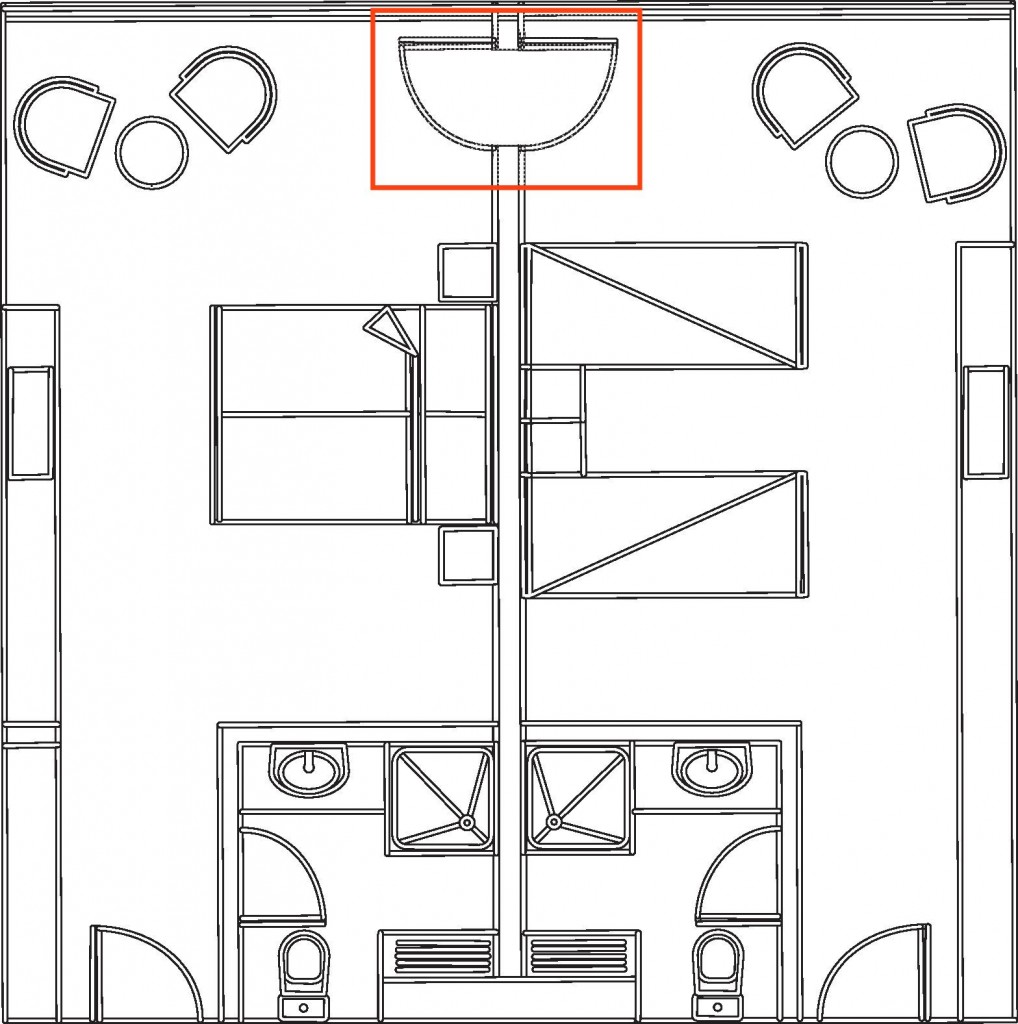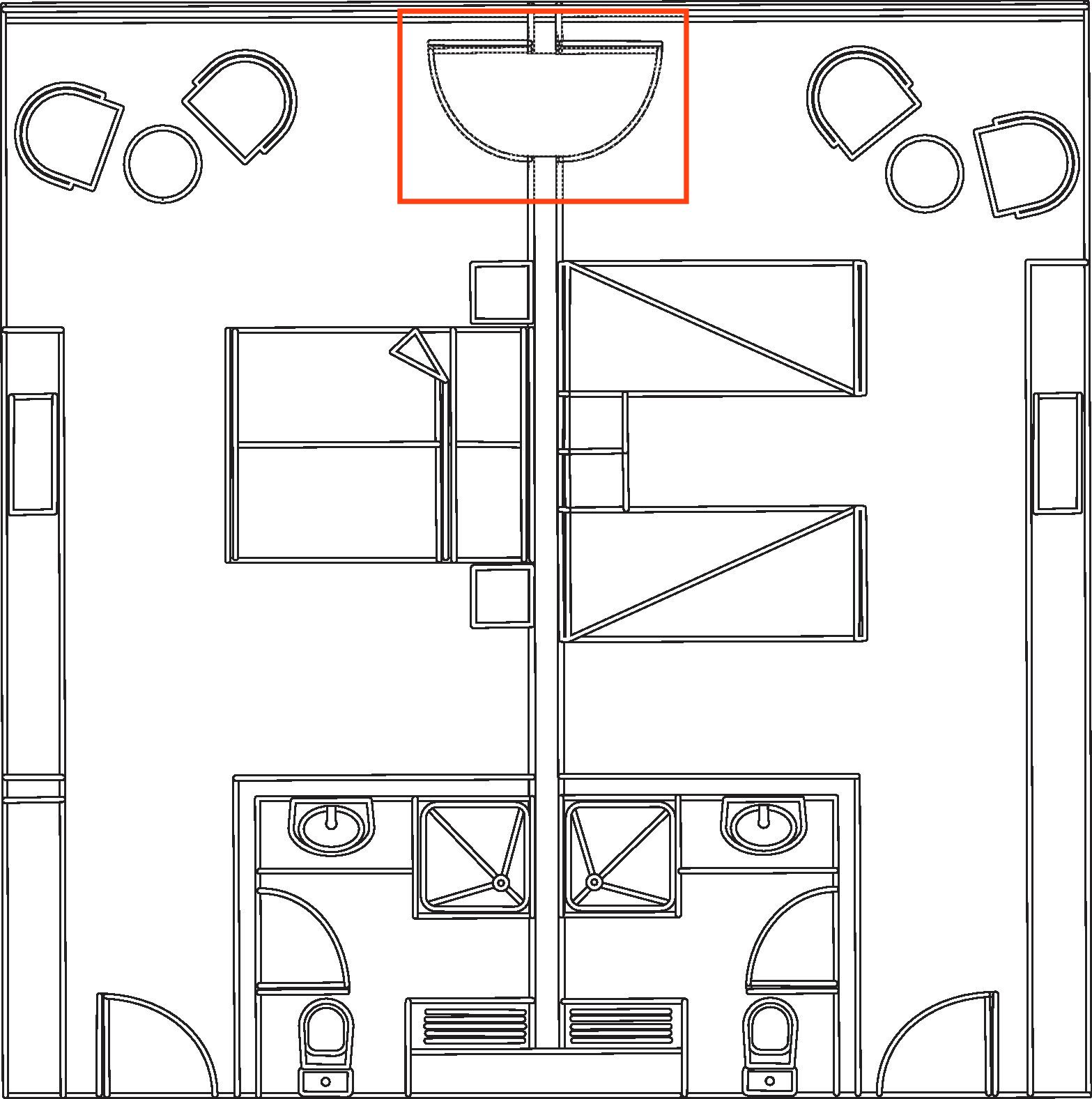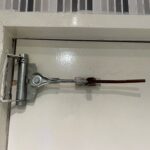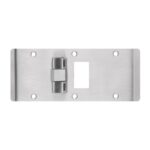This post will be published in the February 2016 issue of Doors & Hardware
 A door opening between two adjoining hotel rooms is called a communicating door, and is created by installing two doors within one frame – each swinging in the opposite direction. The purpose of these doors is to allow convenience for family or friends sharing two hotel rooms, but the doors also provide security when the rooms are occupied by separate parties, as well as maintaining the fire-resistance of the partition between the rooms.
A door opening between two adjoining hotel rooms is called a communicating door, and is created by installing two doors within one frame – each swinging in the opposite direction. The purpose of these doors is to allow convenience for family or friends sharing two hotel rooms, but the doors also provide security when the rooms are occupied by separate parties, as well as maintaining the fire-resistance of the partition between the rooms.
For security purposes, communicating doors between hotel rooms typically have a single-sided deadbolt, with a thumbturn on the room side and a blank plate on the side facing the other communicating door. This requires the occupants of both rooms to unlock their door to allow access between the rooms. These doors may also have gasketing, a door bottom, and a threshold, to help prevent the transmission of sound through the opening. Occasionally, one door with two deadbolts may be used instead of two doors, but more sound will likely pass through the opening if only one door is installed.
The 2015 International Building Code (IBC) requires walls separating sleeping rooms to be constructed as fire partitions in accordance with Section 708 (see Section 420.2). Section 708.3 requires these fire partitions to have a fire-resistance rating of 1 hour, with the exception of sleeping unit separations in buildings of Type IIB, IIIB and VB construction which may have a fire-resistance rating of 1/2 hour if the building is equipped throughout with an automatic sprinkler system.
According to Table 716.5 in the 2015 IBC, a 1-hour fire partition that is not part of a corridor or an exit enclosure requires opening protectives (fire door assemblies) with a rating of 45 minutes. For 1/2-hour partitions, 20-minute fire door assemblies are required. The IBC does not specifically state whether one door or both doors are required to be fire doors. Without prescriptive requirements, it is left up to interpretation by the Authority Having Jurisdiction (AHJ). Some AHJs may require both doors to be labeled because using one fire-rated door and one non-rated door could compromise the fire-resistance of the opening protective if the rated door was open during a fire.
Communicating doors between hotel rooms share many of the same requirements as fire door assemblies in other locations, with one exception. Section 716.5.9 requires fire doors to be latching and self- or automatic-closing, but includes two exceptions. One of those exceptions applies to communicating doors: “1. Fire doors located in common walls separating sleeping units in Group R-1 shall be permitted without automatic- or self-closing devices.” Group R-1 is a Residential occupancy containing sleeping units where the occupants are transient, including hotels, motels, and transient boarding houses and congregant living facilities with more than 10 occupants.
NFPA 101 – The Life Safety Code requires 20-minute doors in this location, and also exempts these doors from being self-closing. The NFPA 101 Handbook explains that the fire separation between sleeping rooms is necessary to confine a fire to the room of fire origin. The Handbook also includes some insight into whether one or both doors are required to be labeled fire doors: “The requirement for a fire barrier separation between the rooms, therefore, necessitates the use of a fire protection–rated door assembly for at least one of the doors in any guest room-to-guest room opening.” Although the Handbook is not technically part of the code, many AHJs rely on it to assist with code interpretations.
The omission of closing devices on communicating doors is also referenced in NFPA 80 – Standard for Fire Doors and Other Opening Protectives. In the 2013 edition of this standard, section 6.4.1.1 requires every fire door to have a closing device except when otherwise permitted by the Authority Having Jurisdiction (AHJ). In Annex A – Explanatory Material, Section A.6.4.1.1 describes limited circumstances where a closer may not be necessary. One location described in this paragraph where a fire door might be installed without a door closer is a communicating door between hotel/motel sleeping rooms.
The reason doors between these sleeping rooms are not required to be self-closing is because when both doors are open, the two rooms become more like a suite which would not typically require a fire separation between them. Note that the exception refers only to the closing device – the doors are not exempt from the latching requirement, and would require a latchset with an active latchbolt in addition to the deadbolt provided for security. The use of locks which require two operations to retract the bolts is acceptable because communicating doors between sleeping rooms are not required for egress.
Consult the code that has been adopted in your project’s jurisdiction for specific requirements. The AHJ is responsible for interpretation of the codes and always has the final say.
Floor Plan: Radu Bercan/Shutterstock.com
You need to login or register to bookmark/favorite this content.








I’ve seen some hotels and dormitories which have one door between the rooms of a pair, but have a
lock with two deadbolts operated by thumb-turns on opposite sides of the door. Is there any particular advantage, besides soundproofing, to the design with two separate doors? I would think that a single fire-rated door would be cheaper than two such.
That’s a good question. I’ve rarely seen it done that way, but other than sound I can’t think of a reason why one door couldn’t work. Maybe someone else has an idea.
– Lori
Could it be that you only need each door to have 1/2 the rating of the opening if there are two doors as opposed to only one door that would need to match the opening’s rating?
I don’t think so. Each door needs to provide the required rating in case the other door is open.
– Lori
NFPA101 edition 2009 &2012 section 28.3.7.3 ( Doors in the barriers required by 28.3.7.1 and 28.3.7.2 shall have a fire protection rating of not less than 20 minutes and shall not be required to be self-closing).
Thanks Nabil!
– Lori
would a single fire rated door be permitted to receive a prep for a positive latching lock and 2 deadbolt preps?
I think so. What do you think?
– Lori
Lori,
When did the requirement change to both leaves needing a fire label? What code requires this? I can’t find requirements or any test results for two mineral core doors in one frame. The only test data I have ever seen is for one solid core and one mineral core door in a communicating frame.
Requiring both doors to be fire labeled is a major change in communicating door requirements.
The purpose of the communicating door has always been to inexpensively add sound attenuation to a fire rated opening. Common walls separating sleeping units are designed with a minimum STC rating of 50.
The historical model for communicating doors in hotels:
Frame: Fire labeled
Leaf A: Fire labeled; mineral core; 1 3/4” thick; steel ball bearing top hinge, UL spring loaded center and bottom hinge; passage latch; double cylinder deadlock; smoke seals; door bottom for sound control.
Leaf B: Solid core; 1 3/8” thick; hinges; exit latch; sound seals.
Leaf A provides all of the fire protection and security. Leaf B is provided ONLY for sound control. The doors make use of the standard unequal rabbet frame profile and the dissimilar door thicknesses and core densities provide additional sound attenuation.
Years ago, a member of the hotel staff would retract the deadbolt when the rooms were rented as adjoining. In the 1990’s we started using a thumbturn x blank plate deadlock on both leaves in lieu of the double cylinder deadlock on one leaf due to changes in the way hotels are managed.
Thanks for sharing your immense code knowledge!
David Christenson, AHC
It’s not necessarily a change, just a matter of interpretation. I have not been able to find anything that specifically states a requirement for one door to be rated or for both to be rated, but when there’s a lack of prescriptive information, it’s up to the AHJ and I typically take the more cautious approach to avoid problems in the field.
Now that the hotel guests have control of the doors (rather than staff), what about this scenario…You are staying in room 101 and I’m staying in room 102 (and we don’t know each other). The fire-rated door is on my side and let’s say you have a cheap hollow-core door on your side. My pesky kids open our fire door, and then set the room on fire. You are not protected because there is only the cheap hollow-core door between you and the fire.
I will ask the ICC and see if I can get an actual answer.
– Lori
Hi David –
I was not able to get a definitive answer on this question, so I edited the article a bit. The lack of a prescriptive requirement means that it will be up to the AHJ whether he wants one or both doors to be labeled. I will add this to my wish list for the next code development cycle. I’m trying to tackle some of these little code mysteries in each cycle.
– Lori
Hi David –
I asked the ICC, and although it is just a staff opinion and not an official interpretation, this was the answer: “In my opinion, if a designer is to take advantage of Exception 1 to Section 716.5.9 (i.e., eliminating the typically required closers for fire doors) then both doors must be fire doors. In point of fact, the exception literally, says “fire doors located in common walls separating sleeping units.”
– Lori
Could find nothing in our HM door procedure that would prohibit 2 deadbolts.
Is it necessary to install cylinder from both side for each face of two shutters
or two handle
because i have on connecting door in the hotel (one frame and two shutters )
please advise or send me sketch for the same
Typically the deadbolts on communicating doors have a thumbturn on the room side, and a blank plate on the side that is in between the two doors. This allows the resident on each side to have control of their door.
– Lori
Hello, and thank you for this article. I don;t even remember how I phrased my question, but you popped on top and I learned the term I seem to have to use.
I want to find out if there should be any problems from a code standpoint in using communicating door as means of separating office or retails suites in a commercial building.
Especially in an office setup this may be an easy way to expand into another suite without having to spend major amount of money; I just sub-divided a large space adjacent to my own suite and very much would like to install a hot connection to it in case I decide to occupy it; on the other hand, if I land a tenant for it I’d just close our door and they’d close theirs and it should be just fine (short from the appearance of a door in the wall).
Code is explicit about “sleeping rooms”, so I guess that portion of it does not apply to my situation.
Any insight is welcome!
Hi Bobby –
It should be ok to use a communicating door (the AHJ could tell you for sure) as long as the door met the requirements for the fire resistance rating of the wall. But in my opinion you would not be able to omit the closer on the door because the exception is limited to communicating doors between sleeping rooms.
– Lori
what about the gap in each door’s threshold – is there such thing as a gap being too wide? this would allow noise and line of sight into the adjacent room? Is there a code for that or industry standard?
Hi Cash –
The maximum clearance at the bottom would be 3/4-inch for fire rating requirements, but I would recommend having the minimum gap that would still allow the door to operate.
– Lori
It’s good practice to add automatic door bottoms to take care of the gap at the threshold and reduce sound transmission.
Section 1206 sets STC ratings for assemblies (walls, ceiling, floors, etc) separating dwelling/sleeping units from each other and from public areas/corridors.
1206.2 lists “entrance” doors as the only exception, however communicating doors aren’t exactly “entrance” doors, or are they?
Door hardware on these doors (gaskets, door bottoms, etc) most likely would meet the STC requirement (plus there’s 2 of them) but seems this is a bit open to interpretation.